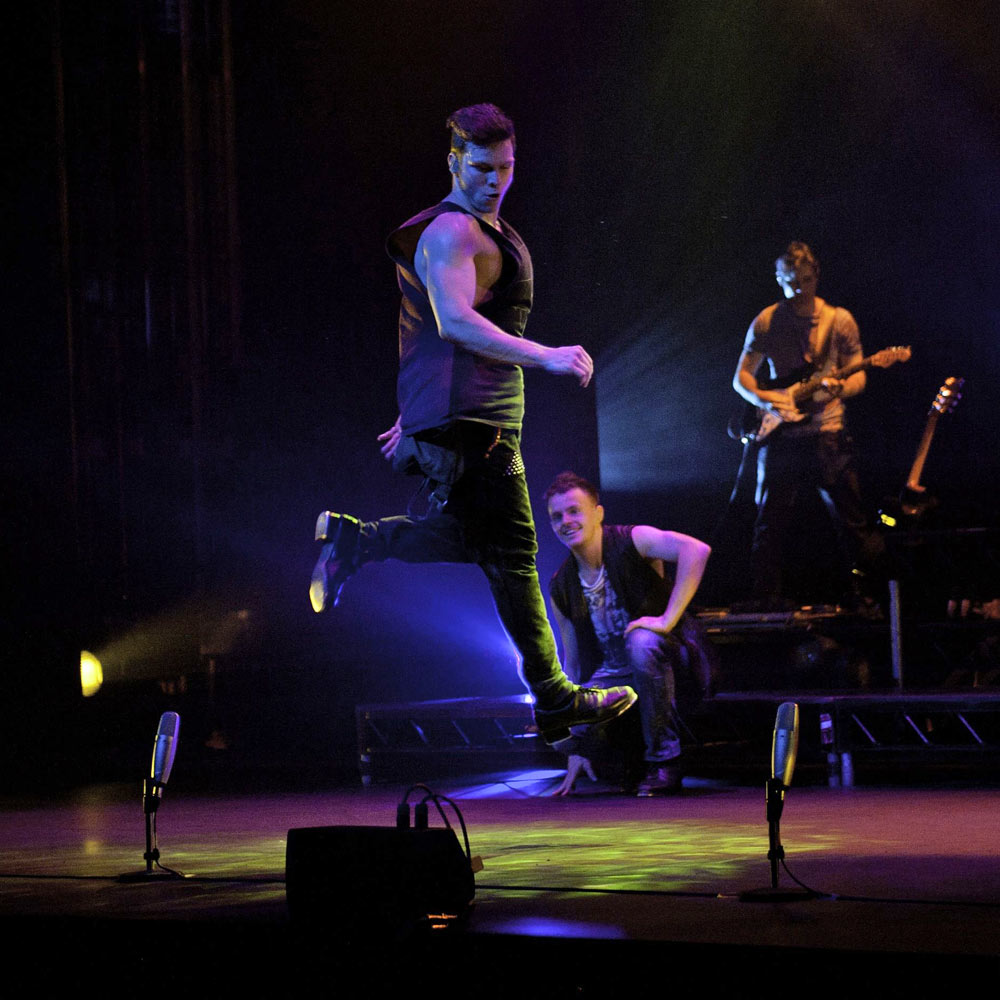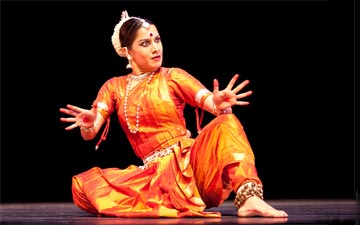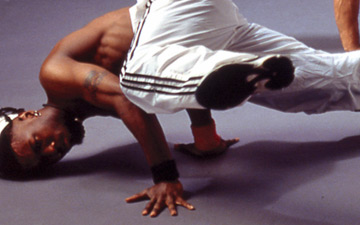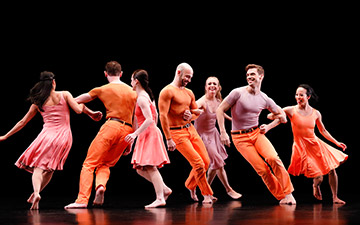
© Amanda Brenchley. (Click image for larger version)
RAW Dance Company
Untapped!
New York, New Victory Theater
★★★✰✰
5 Feb 2016
untappedshow.com
www.rawdancecompany.com
www.newvictory.org
Untapped! is a cheap and cheerful, mildly rowdy show which puts a spring in one’s step. By cheap I mean genuinely accessible: all tickets are under $50, and because it is the New Victory, it is a kid-friendly show, of which there is something of a shortage in live arts entertainment.
Hailing from Australia, Untapped! is the brainchild of Andrew Fee, the founder of RAW Dance Company which provides the cast of five tappers in the current tour. Fee’s Untapped! co-choreographer, Jack Chambers, is one of the deftest dancers on stage Friday night (and the 2008 winner of So You Think You Can Dance in Australia). Untapped!’s cast can certainly tap, but they boast a range of performing backgrounds and training, including ballroom, street and urban styles. There are backflips, barrel turns and pirouettes. While several exceptional rhythms surfaced on the stage, the overall aesthetic of Untapped! is a bit hoot and holler, a bit of cheese but is not an untalented affair. Even though his style is a world away, America’s foremost contemporary tap dancer, Savion Glover, was in the audience that night, which says something about the tightness of the tap community – for as popular as tap is when audiences do see it, tap has become a rarified art.
Untapped! is staged with three musicians – drummer Brendan Ramnath, bassist Jeremy O’Connor and guitarist Mauricio Hosi – and world class beatboxer Genesis Cerezo. The sounds are often loud and rocking, sometimes overly so, burying any potential connection between the taps and the music in a crashing cacophony of percussion and amplification. When the band was in full force, much of the tap rhythms couldn’t be delineated and seemed out of sync; how much of this was mediocre sound quality or the choreography is hard to tell. Judging by the applause (the louder the better), this didn’t seem to bother the audience one iota, but Untapped! fares better from a rhythmic standpoint when the dancers are only lightly accompanied, or go a capella.
The show is divided into nearly 20 sections, but they are short and sweet. The most entertaining of them are the more purely rhythmic. I Hear Voices features the five dancers each engaging with their cell phones, talking (or yelling) into their phones (“Hello?” “HellOOO?” “How ya going?”) on a different note, each with a different rhythmic pattern which contributes to the larger beat pattern, which becomes nearly, but not quite, a song. It is contemporary, the acting is cute, even witty, and a difficult invention to create and pull off. Everyone gets put on hold, rolls their eyes and the band plays the world’s most popular elevator/hold music tune, “The Girl From Ipanema.” The adults guffaw at the “grown up” joke and the tappers gently adjust their rhythms to go with the sway of the in-flight music.
Cerezo gets several spotlights, beatboxing solo onstage and engaging in emcee-style interactions with the audience, including call and response and teaching an eight year old girl a basic beat boxing lesson. He sings snippets of pop songs and has a ventriloquist’s talent for imitating highly specific sounds, ranging from the expected record scratches to more filmic special effects you thought you could only hear at an IMAX cinema. Cerezo’s beatboxing is pure hypnosis, as it is for good tap dancing: it satisfies the human craving for rhythm and a visible demonstration of high craft.
Good Point shows how tap combinations can come together, each dancer building on one another’s steps to create a finished product. While Aussie Thongs might conjure up visions of “Thunder From Down Under,” Untapped!’s sequence is far more innocent, and difficult: the five tappers, somehow, dance in flip flops before sitting down on the floor and using the flops to “play” their torsos in a complicated rhythmic section. The sounds are clear and the audience was brought to a hushed sense of awe. They took it to another level with the goofy Flippin’ Crazy, tapping in swim fins. The children’s giggles were fantastically contagious. Air Drums kept the kids giddy, with Ramnath drumming without a kit and miming on invisible drums. He drops one stick and pulls another magically from his sleeve, plays with different sounds and adds a keyboard, fights a buzzing fly, and the even the adults went “woah” when Cerezo came out from side stage, revealing himself as the sole sonic source.
Given the strict choreographic nature of the show, it is hard to tell if what one sees of the dancers reflects their personal style or choreographic dictations. In Untapped! at least, Brianna Taylor is ruthless and speedy while Sally Hare is a more sensuous, slinkier and more responsive tapper. Chambers had the most accurate rhythm, musicality and tightness, which is in tune with his job as co-choreographer. Kieran Heilbronn has a gift for humor and athleticism, and Ginner Whitcombe is a very solid, all-round capable tapper and cheery performer.

© Amanda Brenchley. (Click image for larger version)
Untapped! is not for everyone, and some hard core tap fanatics might find the Aussie rock and roll take on tap a bit much, but it deserves commendation for providing an accessible, energizing, all-ages show that delights, and makes you want to take a tap class. In the grander scheme of things, it’s been a long time since tap has had a “home” (some might argue that it never has) and in a way Untapped! – a quasi-Broadway show, not quite of it and not quite separate from it – is an example of this.
Tap used to be a bigger part of the pop culture consciousness, featuring frequently in feature films. For most of the 20th century, people’s parents and grandparents had memories of vaudeville shows and variety acts. While ballet, modern and contemporary dance grew to be more systematic and formalized, they benefited from society’s favoritism for organization and were able to get more funding. Tap is an organic, visceral dance form that can’t be corralled in the same way; it isn’t dictated by strict, separate schools of thoughts with different names attached (though there are a variety of distinct styles and key performers). Ironically, despite being the low key art form (no fancy costumes required, no genetic turnout/flexibility/height/weight constraints etc.), that should have been more accessible and more frequently performed, as the 20th century wore on, performing opportunities for tappers dwindled. Excellent tappers are closer to freelance musicians than other professional dancers, both in what they do and in how they survive, taking different gigs of different types, almost always including teaching. Oddly, despite many kids taking tap as an extracurricular alongside ballet, jazz and drama classes, there are few outlets once they reach the highest level of skill (and still fewer if they don’t live in New York), but one can hope.
Glover, not that the future of tap should reside solely with him but, he has an inevitable fated role in it, has been more active of late and is about to launch the highly anticipated revival of Shuffle Along, which will not only draw from a fresh audience (Glover’s Bring in ‘da Noise, Bring in ‘da Funk premiered two decades ago), it will bring tap – and its history – squarely back into the dance and arts dialogue. Michelle Dorrance was on The Late Show with Stephen Colbert, showing a whole new audience the art of tap as instrument, rhythm keeper and rhythm maker. Jennifer Homans, in her ballet history tome Apollo’s Angels, tolled the death knell for ballet in her epilogue The Masters are Dead and Gone; many did not agree, but she dared to write about the possible end of a longstanding, iconic art form. Is the fate of tap so dismal? Tap is arguably the most accessible dance form: it satiates a primal need in everyone to access a communal rhythm. Judging by the children’s gleeful skips and screams at the end of Untapped!, tap is far from done, and we are all clamoring for more.

















You must be logged in to post a comment.